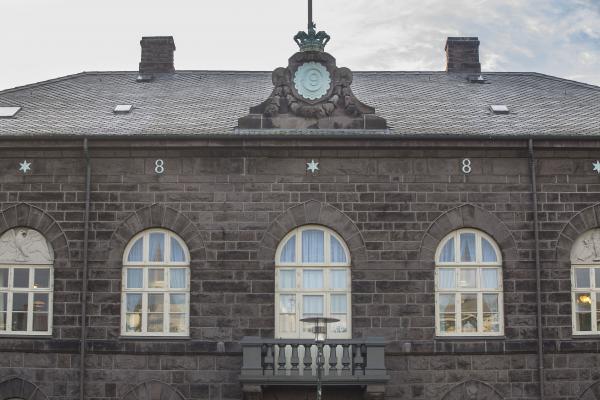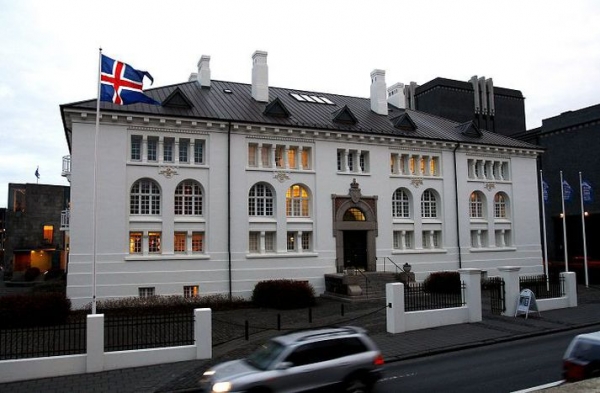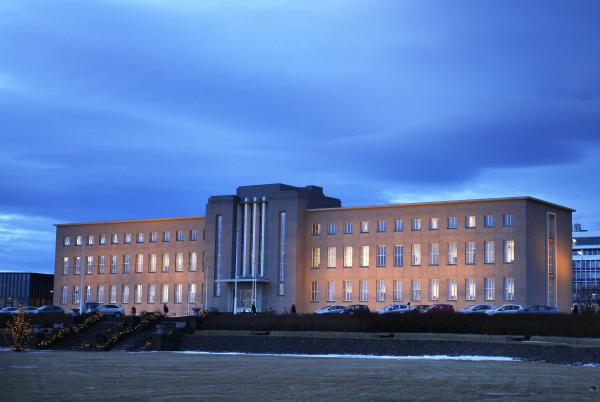Most Icelanders would probably consider the center of Reykjavík to be in Austurvöllur square which lies in front of the house of parliament, Alþingishúsið. Alþingishúsið is certainly the focus of Icelandic political life, the symbol of both political power and a democratic tradition which stretches all the way back to the settlement of Iceland.
Alþingi: The Assembly of All

Alþingi, which translates as The Assembly of All, was the highest political institution of the the Viking Age commonwealth, both a legislature and a court. Founded in 930 at Þingvellir (The Fields of Parliament) beneath Almannagjá gorge in ÞIngvellir National Park, Alþingi is sometimes said to be the oldest continually operating parliament in the world.
Today's Alþingi is, of course, very different from the original institution. But it is still the most important political institution in Iceland. When Icelanders feel they need to have their voice heard, and feel that writing or calling their representative, signing petitions or voting in elections is not enough, they will gather at Austurvöllur square to remind the MPs that they represent the people, that Parliament is in fact still the Assembly of All.
Alþingishúsið: A small but important building
The building which houses Alþingi, Alþingishúsið, is therefore one of the most important buildings in Reykjavík, it's importance not matched by its size! But, then again, Iceland is a country of contrasts. While some things are surprisingly small (like the Reykjavík cathedral, which is the small church next to the house of parliament, not the giant church Hallgrímskirkja which towers over Reykjavík) the size of other thing seems completely out of proportion. Like the landscape!
To help you get to know this important landmark we at Iceland Insider put together a list of things you probably didn't know about Alþingishúsið,
1: It was to be built by donations from the public
The Icelandic parliament had met at Þingvellir since 930. First the meetings were held outdoors, but later a house was built for the assembly. In 1789 the last of these was close to collapse, causing representatives to complain about damp, draft and cold.

Parliament did not meet between 1800 and 1845 when the newly reconvened assembly met in the building of the Reykjavík Junior College, Menntaskólinn í Reykjavík. In 1867 parliament decided that it would be appropriate to commemorate the 1000 year anniversary of the settlement of Iceland in 1874 by building a new parliament building in downtown Reykjavík. Instead of funding this new project parliament decided to appeal to the citizens to fund the construction with donations.
This did not work out, as could perhaps have been expected. Iceland was at the time one of the poorest countries in Western Europe. In 1879 parliament therefore decided to pay for the construction out of public funds, as only a fraction of the projected cost had been collected.
When the construction was complete the total cost came to about 790,000 USD at today's prices. This included an aborted foundation on Laugavegur street, where the house was originally to be built.
2: It was originally supposed to stand on Laugavegur street!
After the funding had been secured and plans for the house drawn up the construction started. But first a site had to be picked.

Some advocated for the house to be built on Arnarhóll hill, the small hill on the eastern edge of the old harbour. A key argument for this location was that the land was owned by the state. Others argued it was inappropriate to place the house of parliament at the outskirts of Reykjavík: Arnarhóll was at this time at the eastern edge of the small town!
The committee overseeing the construction therefore opted for a plot of land at the corner of Ingólfsstræti street and Bankastræti street, on the norther side of the street. In the fall of 1879 construction began at this site.
3: The original site is abandoned, leading to a smaller building
When the chief carpenter in charge of the construction arrived from Denmark and the masons who had been hired from Denmark to oversee the construction arrived in Iceland in the spring of 1880 they quickly stopped the construction at the original site, arguing it was impractical. A new site was picked by Austurvöllur in the center of town.
However, the foundation for the house had already been dug and other work carried out, all of which was now wasted. This put a significant dent in the budget of the project. In the 19th century officials had not yet adopted the modern culture of cost-overruns, so the team simply cut down the size of the house to account for the money already spent on the abandoned start. Originally the plans had included a half-buried basement beneath and stairs leading up to the front entrance. This basement was now scrapped.
Alþingishúsið is therefore significantly smaller than originally envisioned!
4: The stone came from Skólavörðuholtið hill
Alþingishúsið is built from gray dolertie, a volcanic rock similar to volcanic basalt. The stones were quarried in the rocky slopes of Skólavörðuholt, the hill east of downtown. The main quarry was located where the present day street of Óðinsgata is located.
In addition to the Danish expert masons and carpenters overseeing the construction at least 100 Icelanders worked quarrying the rock, transporting it to the site and working at the construction site. The walls on the lower floor of the house are 80 cm (31.5 in) thick, the second floor walls are 63 cm (25 in) thick while the third floor walls are 36 cm (14 in). The cornerstone has a large silver shield inscribed with the names of the architect and others who planned the building, as well as the inscription Truth will set you free.
5) The decoration on the front: King and four Landvættir

The house is literally crowned with the crown of Christian IX king of Denmark, who was the monarch of Iceland when the house was completed. The date 1881 beneath the roof refer to the year when the house wa completed.
Reliefs over four of the windows on the second floor present the four mythical Landvættir of Iceland, the giant, the eagle, the bull and the dragon. The Landvættir are pagan land spirits who guard Iceland.
Each of the spirits guards a part of Iceland against external threats and dangers. The dragon protects the Eastfjords, the eagle protects the fjords of the north, the great bull protects the west and the giant stands guard at Reykjanes peninsula in the south-west. The legend has it that the South coast needed no protection as the deadly surf of the black sand beaches would keep invaders at bay.
6) It also housed the National Museum, Gallery, Library and Archives

When the house was completed in 1881 it was big enough to double as the home of the National Library and the National History Museum. While parliament was given the second floor, the ground floor was home to parliamentary offices as well as the national library. The National History Museum was housed on the third floor. When the National Gallery was founded in 1885 it was also given rooms in Alþingishúsið. The National Archives were also housed in the building.
In 1908 the National Museum, National Library and the National Archives were moved into Safnafnahúsið, the Culture House, which is still home to an exhibition which showcases pieces from all of Iceland's museums.
However, the National Gallery remained in the house of parliament until 1950.
7) Even the University used it for classrooms

With the National Library, Archives and Museum out of Alþingishúsið parliament again had plenty of room to spare. In 1911 the newly founded University of Iceland therefore moved into Alþingishúsið. The two institutions were able to share the building because in those years parliament was only in session during the summer, while classes at the University were during the winter.
The University and Parliament continued to share Alþingishúsið until 1940 when the University finally moved into it's own building south of downtown.
Most Icelanders would probably consider the center of Reykjavík to be in Austurvöllur square which lies in front of the house of parliament, Alþingishúsið. Alþingishúsið is certainly the focus of Icelandic political life, the symbol of both political power and a democratic tradition which stretches all the way back to the settlement of Iceland.
Alþingi: The Assembly of All

Alþingi, which translates as The Assembly of All, was the highest political institution of the the Viking Age commonwealth, both a legislature and a court. Founded in 930 at Þingvellir (The Fields of Parliament) beneath Almannagjá gorge in ÞIngvellir National Park, Alþingi is sometimes said to be the oldest continually operating parliament in the world.
Today's Alþingi is, of course, very different from the original institution. But it is still the most important political institution in Iceland. When Icelanders feel they need to have their voice heard, and feel that writing or calling their representative, signing petitions or voting in elections is not enough, they will gather at Austurvöllur square to remind the MPs that they represent the people, that Parliament is in fact still the Assembly of All.
Alþingishúsið: A small but important building
The building which houses Alþingi, Alþingishúsið, is therefore one of the most important buildings in Reykjavík, it's importance not matched by its size! But, then again, Iceland is a country of contrasts. While some things are surprisingly small (like the Reykjavík cathedral, which is the small church next to the house of parliament, not the giant church Hallgrímskirkja which towers over Reykjavík) the size of other thing seems completely out of proportion. Like the landscape!
To help you get to know this important landmark we at Iceland Insider put together a list of things you probably didn't know about Alþingishúsið,
1: It was to be built by donations from the public
The Icelandic parliament had met at Þingvellir since 930. First the meetings were held outdoors, but later a house was built for the assembly. In 1789 the last of these was close to collapse, causing representatives to complain about damp, draft and cold.

Parliament did not meet between 1800 and 1845 when the newly reconvened assembly met in the building of the Reykjavík Junior College, Menntaskólinn í Reykjavík. In 1867 parliament decided that it would be appropriate to commemorate the 1000 year anniversary of the settlement of Iceland in 1874 by building a new parliament building in downtown Reykjavík. Instead of funding this new project parliament decided to appeal to the citizens to fund the construction with donations.
This did not work out, as could perhaps have been expected. Iceland was at the time one of the poorest countries in Western Europe. In 1879 parliament therefore decided to pay for the construction out of public funds, as only a fraction of the projected cost had been collected.
When the construction was complete the total cost came to about 790,000 USD at today's prices. This included an aborted foundation on Laugavegur street, where the house was originally to be built.
2: It was originally supposed to stand on Laugavegur street!
After the funding had been secured and plans for the house drawn up the construction started. But first a site had to be picked.

Some advocated for the house to be built on Arnarhóll hill, the small hill on the eastern edge of the old harbour. A key argument for this location was that the land was owned by the state. Others argued it was inappropriate to place the house of parliament at the outskirts of Reykjavík: Arnarhóll was at this time at the eastern edge of the small town!
The committee overseeing the construction therefore opted for a plot of land at the corner of Ingólfsstræti street and Bankastræti street, on the norther side of the street. In the fall of 1879 construction began at this site.
3: The original site is abandoned, leading to a smaller building
When the chief carpenter in charge of the construction arrived from Denmark and the masons who had been hired from Denmark to oversee the construction arrived in Iceland in the spring of 1880 they quickly stopped the construction at the original site, arguing it was impractical. A new site was picked by Austurvöllur in the center of town.
However, the foundation for the house had already been dug and other work carried out, all of which was now wasted. This put a significant dent in the budget of the project. In the 19th century officials had not yet adopted the modern culture of cost-overruns, so the team simply cut down the size of the house to account for the money already spent on the abandoned start. Originally the plans had included a half-buried basement beneath and stairs leading up to the front entrance. This basement was now scrapped.
Alþingishúsið is therefore significantly smaller than originally envisioned!
4: The stone came from Skólavörðuholtið hill
Alþingishúsið is built from gray dolertie, a volcanic rock similar to volcanic basalt. The stones were quarried in the rocky slopes of Skólavörðuholt, the hill east of downtown. The main quarry was located where the present day street of Óðinsgata is located.
In addition to the Danish expert masons and carpenters overseeing the construction at least 100 Icelanders worked quarrying the rock, transporting it to the site and working at the construction site. The walls on the lower floor of the house are 80 cm (31.5 in) thick, the second floor walls are 63 cm (25 in) thick while the third floor walls are 36 cm (14 in). The cornerstone has a large silver shield inscribed with the names of the architect and others who planned the building, as well as the inscription Truth will set you free.
5) The decoration on the front: King and four Landvættir

The house is literally crowned with the crown of Christian IX king of Denmark, who was the monarch of Iceland when the house was completed. The date 1881 beneath the roof refer to the year when the house wa completed.
Reliefs over four of the windows on the second floor present the four mythical Landvættir of Iceland, the giant, the eagle, the bull and the dragon. The Landvættir are pagan land spirits who guard Iceland.
Each of the spirits guards a part of Iceland against external threats and dangers. The dragon protects the Eastfjords, the eagle protects the fjords of the north, the great bull protects the west and the giant stands guard at Reykjanes peninsula in the south-west. The legend has it that the South coast needed no protection as the deadly surf of the black sand beaches would keep invaders at bay.
6) It also housed the National Museum, Gallery, Library and Archives

When the house was completed in 1881 it was big enough to double as the home of the National Library and the National History Museum. While parliament was given the second floor, the ground floor was home to parliamentary offices as well as the national library. The National History Museum was housed on the third floor. When the National Gallery was founded in 1885 it was also given rooms in Alþingishúsið. The National Archives were also housed in the building.
In 1908 the National Museum, National Library and the National Archives were moved into Safnafnahúsið, the Culture House, which is still home to an exhibition which showcases pieces from all of Iceland's museums.
However, the National Gallery remained in the house of parliament until 1950.
7) Even the University used it for classrooms

With the National Library, Archives and Museum out of Alþingishúsið parliament again had plenty of room to spare. In 1911 the newly founded University of Iceland therefore moved into Alþingishúsið. The two institutions were able to share the building because in those years parliament was only in session during the summer, while classes at the University were during the winter.
The University and Parliament continued to share Alþingishúsið until 1940 when the University finally moved into it's own building south of downtown.






